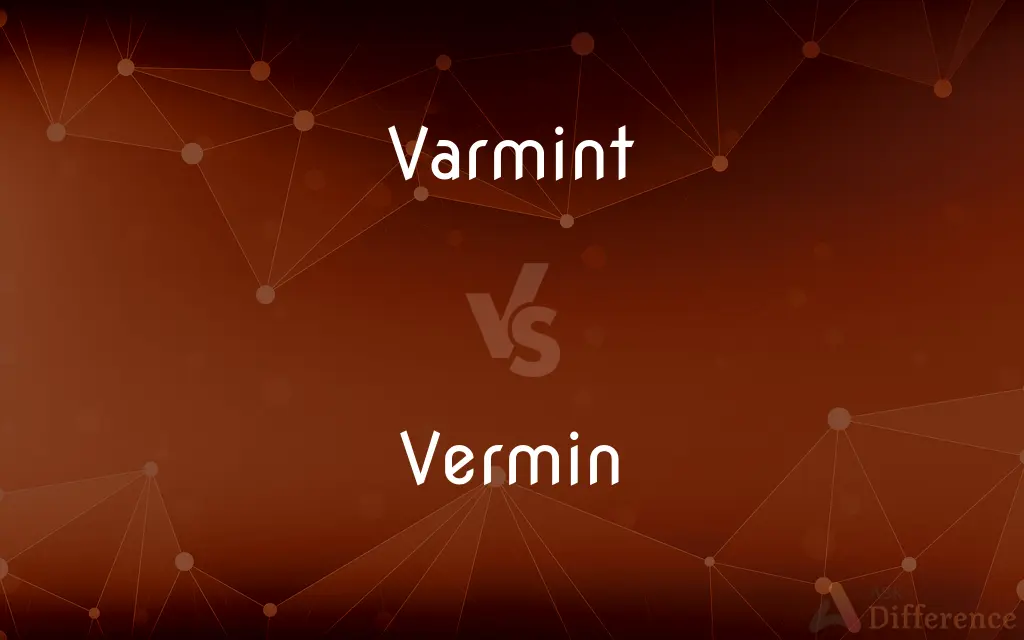Varmint vs. Vermin — What's the Difference?
Edited by Tayyaba Rehman — By Urooj Arif — Updated on March 7, 2024
Varmint refers to troublesome wild animals, typically those harmful to crops or livestock, while vermin are pests or nuisance animals that spread diseases or destroy property.

Difference Between Varmint and Vermin
Table of Contents
ADVERTISEMENT
Key Differences
Varmint generally denotes wild animals considered pests due to their impact on agriculture or game animals. These can include creatures like coyotes or raccoons, which may prey on livestock or damage crops. On the other hand, vermin refers to animals or insects regarded as pests primarily because they pose health risks, spread diseases, or cause structural damage. Examples include rats, mice, and cockroaches.
While the term varmint can have a broad application, often used colloquially in rural settings to describe any problematic wildlife, vermin specifically connotes a negative impact on human habitats and health. This distinction underscores the latter's association with filth and disease, whereas the former might simply be seen as a nuisance to property or livelihood.
Public perception of varmints and vermin also varies, with varmints sometimes considered a part of rural life and natural ecosystems, albeit inconvenient. Vermin, however, are almost universally viewed negatively due to their association with uncleanliness and health risks. This distinction influences how communities and individuals approach the management and mitigation of these animals.
Legislation and regulations surrounding the control of varmints and vermin reflect the different attitudes and dangers they represent. Varmint management might be regulated under game laws, with specific seasons and methods for control, while vermin control often falls under public health guidelines, emphasizing eradication and prevention of infestation.
Despite the differences, both varmints and vermin share the commonality of being considered pests. The key distinction lies in the nature of the threat they pose—varmints affecting agriculture and livestock versus vermin impacting human health and property.
ADVERTISEMENT
Understanding the differences between varmints and vermin is crucial for effective pest management strategies, ensuring that measures taken are appropriate to the specific challenges posed by these animals. This knowledge aids in balancing the ecological roles of wildlife with the protection of human health and economic interests.
Comparison Chart
Definition
Troublesome wild animals harmful to crops/livestock
Pests that spread diseases or destroy property
Examples
Coyotes, raccoons
Rats, mice, cockroaches
Associated Problems
Damage to agriculture, threat to game species
Health risks, property damage
Control Methods
Trapping, hunting, exclusion
Sanitation, pesticides, eradication
Public Perception
Sometimes seen as part of rural life
Viewed negatively due to health risks
Regulations
Often under game laws
Usually under public health guidelines
Impact
Primarily agricultural and ecological
Human health and property
Compare with Definitions
Varmint
Wild animals considered pests, especially those affecting agriculture or livestock.
Farmers often consider coyotes varmints because they can prey on sheep and chickens.
Vermin
Small animals or insects that carry diseases and may damage crops or property.
Rats are considered vermin due to their role in spreading diseases.
Varmint
A term used in hunting and pest control to refer to small game animals regarded as pests.
He's going varmint hunting to help control the population of groundhogs damaging the fields.
Vermin
A term often used to describe any creature deemed a nuisance or threat to public health.
Public health campaigns aim to reduce vermin populations in urban areas.
Varmint
A term of disparagement used to describe a person one considers troublesome or mischievous.
The old man called the mischievous kids little varmints as they ran through his garden.
Vermin
In a derogatory sense, used to describe objectionable or disgusting persons or things.
The slumlord referred to his tenants as vermin, showing his disrespect.
Varmint
In colloquial use, any generally troublesome or annoying animal.
That raccoon getting into the trash again is such a varmint.
Vermin
Organisms regarded as pests due to their impact on agriculture, such as insects or rodents.
Farmers use pesticides to protect their crops from vermin like locusts.
Varmint
Animals targeted in varmint hunting, a sport aimed at pest control rather than for food.
Varmint hunting focuses on species like prairie dogs and crows, rather than deer or turkey.
Vermin
Creatures targeted by extermination due to their harmful effects on human environments.
Exterminators are hired to remove vermin infestations from homes and businesses.
Varmint
A troublesome wild animal.
Vermin
Vermin (colloquially varmint(s) or varmit(s)) are pests or nuisance animals that spread diseases or destroy crops or livestock. Since the term is defined in relation to human activities, which species are included vary by region and enterprise.
Varmint
One that is considered undesirable, obnoxious, or troublesome.
Vermin
Wild animals that are believed to be harmful to crops, farm animals, or game, or which carry disease, e.g. rodents
Killed as vermin or game, the pumas have gone
Varmint
A pestering animal such as one that kills or harasses a farmer's livestock or crops.
Vermin
Any one of various common types of small insects or animals which cause harm and annoyance.
The area was plagued by all sorts of vermin: fleas, lice, mice, and rats to name a few.
Varmint
(by extension) An obnoxious person or troublemaker.
Vermin
Animals that prey on game, such as foxes or weasels.
Varmint
An irritating or obnoxious person
Vermin
Obnoxious, or mean and offensive person or people.
Bring these vermin to the Palace of Justice.
Varmint
Any usually predatory wild animal considered undesirable; e.g. coyote
Vermin
An animal, in general.
Wherein were all manner of fourfooted beasts of the earth, and vermin, and worms, and fowls.
This crocodile is a mischievous fourfooted beast, a dangerous vermin, used to both elements.
Vermin
A noxious or mischievous animal; especially, noxious little animals or insects, collectively, as squirrels, rats, mice, worms, flies, lice, bugs, etc.
Great injuries these vermin, mice and rats, do in the field.
They disdain such vermin when the mighty boar of the forest . . . is before them.
Vermin
Hence, in contempt, noxious human beings.
You are my prisoners, base vermin.
Vermin
An irritating or obnoxious person
Vermin
Any of various small animals or insects that are pests; e.g. cockroaches or rats
Common Curiosities
What types of animals are classified as vermin?
Vermin include pests like rats, mice, and cockroaches, known for spreading diseases and causing property damage.
Why are vermin universally viewed negatively?
Vermin are associated with disease transmission, uncleanliness, and property damage, posing direct threats to human health and habitats.
Can the classification of an animal as a varmint or vermin change?
Yes, the classification can change based on the context of the animal's impact on human activities, health, and environment.
What defines an animal as a varmint?
Animals considered varmints are typically wild and harmful to agriculture or livestock, often targeted for control due to their detrimental impacts.
Are there any benefits to having varmints in the ecosystem?
Yes, despite their nuisance to humans, varmints can play important roles in their ecosystems, such as controlling insect populations or as prey for other wildlife.
Why might someone go varmint hunting?
Varmint hunting is often undertaken for pest control purposes, to protect crops or livestock, and sometimes as a sport.
Can vermin affect agricultural productivity?
Yes, vermin can damage crops, eat stored grains, and harm livestock, significantly impacting agricultural productivity.
How do urban environments influence vermin populations?
Urban environments often provide ample food and shelter for vermin, leading to increased populations and the need for effective control measures.
What are some humane ways to control varmints?
Humane control methods include exclusion techniques, habitat modification, and non-lethal traps, aiming to minimize harm while controlling populations.
How do control methods for varmints and vermin differ?
Varmints are controlled through hunting, trapping, or exclusion, focusing on agricultural protection, while vermin control involves sanitation, pesticides, and eradication to protect human health.
What laws regulate the control of varmints and vermin?
Control is regulated by various laws, including game laws for varmints and public health guidelines for vermin, varying by jurisdiction.
How does public perception affect the management of varmints and vermin?
Public perception influences the strategies and regulations for managing these animals, balancing humane treatment with the need for control.
What health risks are associated with vermin?
Vermin can spread diseases such as leptospirosis, hantavirus, and salmonellosis, among others, posing significant public health risks.
Can vermin control be environmentally friendly?
Yes, environmentally friendly vermin control methods focus on prevention, natural predators, and biodegradable pesticides to minimize ecological impact.
Share Your Discovery

Previous Comparison
Manner vs. Matter
Next Comparison
Peninsula vs. CapeAuthor Spotlight
Written by
Urooj ArifUrooj is a skilled content writer at Ask Difference, known for her exceptional ability to simplify complex topics into engaging and informative content. With a passion for research and a flair for clear, concise writing, she consistently delivers articles that resonate with our diverse audience.
Edited by
Tayyaba RehmanTayyaba Rehman is a distinguished writer, currently serving as a primary contributor to askdifference.com. As a researcher in semantics and etymology, Tayyaba's passion for the complexity of languages and their distinctions has found a perfect home on the platform. Tayyaba delves into the intricacies of language, distinguishing between commonly confused words and phrases, thereby providing clarity for readers worldwide.
















































